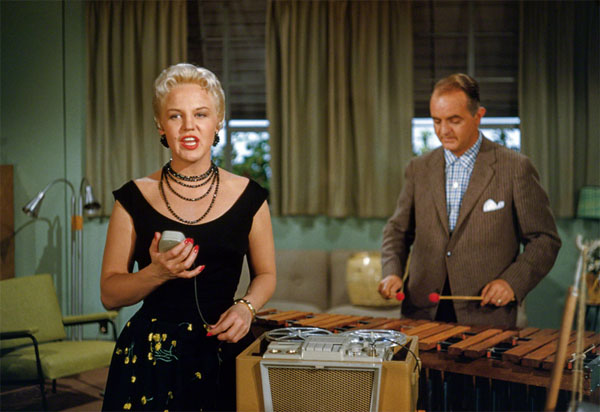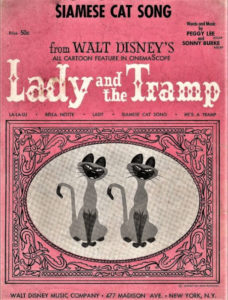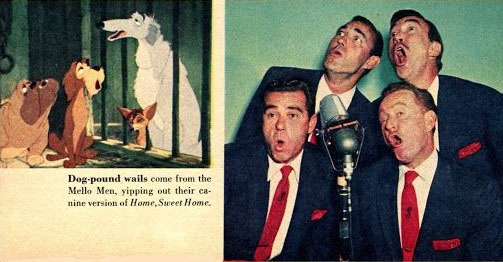
Peggy Lee and Sonny Burke at the Disney Studio
When Lady And The Tramp was being prepared, people working on it may not have been aware of the changes that were going on–both in the music/record industry, and at the Walt Disney studio itself.
 Walt himself may have been preoccupied with matters that had little or naught to do with animation. There was, after all, a new television project which required work. And there was the matter of a little real-estate deal down in Orange County, California – something called a “theme park”.
Walt himself may have been preoccupied with matters that had little or naught to do with animation. There was, after all, a new television project which required work. And there was the matter of a little real-estate deal down in Orange County, California – something called a “theme park”.
What’s more, neither Alice In Wonderland nor Peter Pan produced songs that burned up the popular music charts–not in the same ways that Cinderella or Song of the South–or even So Dear To My Heart had done.
Still, the effort was made.
Arranger-bandleader Sonny Burke was called on to write the music–and singer Peggy Lee was brought in to do the lyrics. By December, 1954, they had several songs written–and, that month, Decca recorded a session in which Peggy did four of the songs from the upcoming film.
All four of them were issued on extended play 45s and on long-playing discs. Two of them–“La La Lu” and “Bella Notte” were issued on Decca (9-29460 a few months later.
A second session was held on February 11, 1955–and that produced two more sides from the score. Sy Oliver was brought in to conduct, and the two sides–“He’s A Tramp” and “The Siamese Cat Song”–were advertised in the next week’s issue of “The Billboard”.
The studio recordings do not feature “The Pound Hounds”– who are, actually, the Mello-Men, a prominent vocal group which backed up singers as diverse as George Burns, Tex Ritter, Kirk Douglas and Elvis Presley. Their most famous member was their bass singer, Thurl Ravenscroft–who is seen having a ball on a segment used in a “Disneyland” TV episode where they and Peggy are shown recording “He’s a Tramp”. Ravenscroft did much more work–not only for Disney (“Grim Grinning Ghosts” from the “Haunted Mansion” ride), but for others, including long-running gig as Tony the Tiger, pushing Kellogg’s Sugar-Frosted Flakes.

Two of the Lee sides–“La La Lu” and ‘The Siamese Cat Song”–were also issued in Decca’s successful Children’s series later in 1955. I think we can understand why “He’s A Tramp” was not reissued in the Decca children’s series–it’s a little too sophisticated for the moppet trade.
NEXT MONTH: More dogs, more covers.


 James Parten has overcome a congenital visual disability to be acknowledged as an expert on the early history of recorded sound. He has a Broadcasting Certificate (Radio Option) from Los Angeles Valley College, class of 1999. He has also been a fan of animated cartoons since childhood.
James Parten has overcome a congenital visual disability to be acknowledged as an expert on the early history of recorded sound. He has a Broadcasting Certificate (Radio Option) from Los Angeles Valley College, class of 1999. He has also been a fan of animated cartoons since childhood.












































“A Cavalcade of Songs” is a great time capsule of Disney music, recounting the hit Disney songs to date up to the mid 1950’s. The last part of the program throws its emphasis on the then-current “Lady and the Tramp.” It’s a fascinating look at the behind-the-scenes recording sessions, though obviously sweetened and idealized for TV audiences.
Though the Disneyland TV show was originally broadcast in black-and-white, several of the individual shows, including “A Cavalcade of Songs” were filmed in color. This made them still-viable many years later and worthy of being re-run in the era of color TV. “Lady and the Tramp” was re-issued to theatres in the early 70’s and “Cavalcade” was aired on “The Wonderful World of Disney” just in time to promote the re-release. Its effectiveness even at that late date can be measured by the fact that my brother, who was not a diehard Disney fan like I was, was intrigued enough by the plot synopsis offered and the tantalizing bits of animation shown, to declare that he wanted to see “Lady and the Tramp.” I’m sure there were lots of little brothers and little sisters who were equally convinced by the re-broadcast to check out the re-issue. A good example of Disney synergy at its finest.